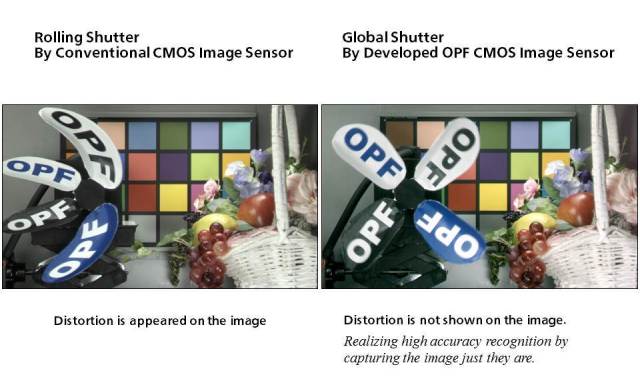Feb 8 2016
Panasonic Corporation today announced that it has developed a new highly functional global shutter technology for a CMOS image sensor using organic photoconductive film (OPF)*1. This technology enables the capture of a high speed moving object in up to 10 times brighter*2 scenes in global shutter mode.
With the OPF CMOS image sensor, the charge-storage function and photoelectric-conversion function can be set independently. By utilizing this unique feature of the OPF CMOS image sensor, this technology solves the degradation of saturation signal in a conventional image sensor with global shutter function. Motion direction can be detected from an acquired objectfs signal level in one picture through fine control of shutter sensitivity by changing applied voltage to OPF, which cannot be realized by conventional CMOS image sensors.
 Captured images of a rotating propeller using different shutter modes (Graphic: Business Wire)
Captured images of a rotating propeller using different shutter modes (Graphic: Business Wire)
This newly developed highly functional global shutter technology contributes to high speed image sensing of moving objects without the image distortion that appears in a conventional shutter operation under very bright conditions. We expect this technology to be used widely in motion capture applications and also to be extended to other applications thought to be difficult to realize without a high saturation global shutter or variable sensitivity multiple exposures.
The new technology offers the following advantages.
- Wide incident angle (60 degrees), high sensitivity, high saturation and highly-functional circuits due to the unique feature of OPF, in which an OPF for photoelectric-conversion and readout circuits are independent.
- High saturation signal up to 10 times larger than conventional image sensors with global shutter function due to Photoelectric Conversion Controlled Global Shutter Technology.
This development is based on the following new technologies
- CMOS Image Sensor Design Technology, where the OPF photoelectric-conversion part and the circuit part can be designed independently.
- Photoelectric Conversion Controlled Global Shutter Technology realized by controlling organic photoconductive film sensitivity.
- Variable Sensitivity Multiple Exposure Technology that can detect motion and its direction by changing image capturing sensitivity in each frame.
Panasonic holds 60 Japanese patents and 41 overseas patents (including pending) related to this technology.
Panasonic presented part of the research at the international conference ISSCCiInternational Solid-State Circuit Conferencej2016 which was held in San Francisco, USA from January 31 to February 4.
Notes:
*1: We use an organic photoconductive film (OPF) developed by FUJIFILM Corporation.
*2: Saturation signal per pixel area compared with conventional silicon based CMOS image sensors with global shutter function.